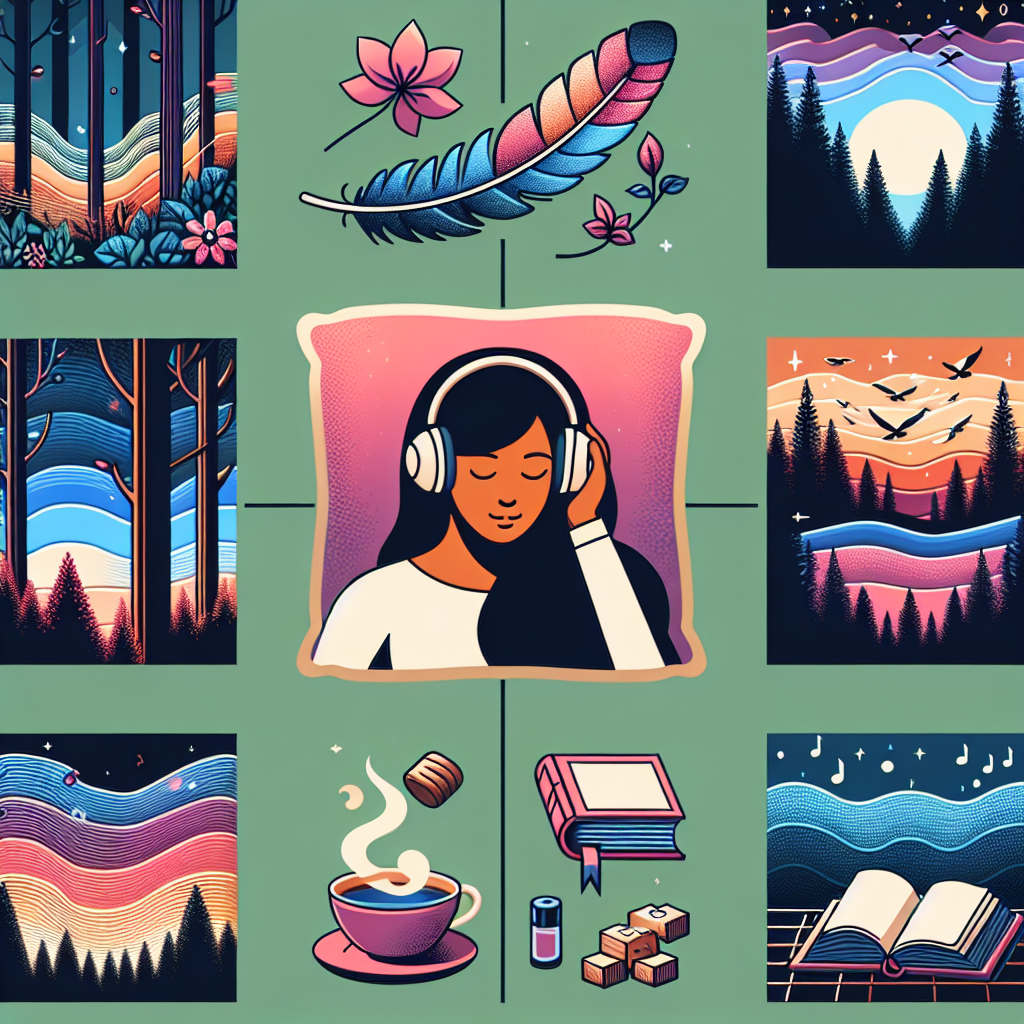
The Soothing World of ASMR: A Gateway to Relaxation and Calm
Imagine a world where stress and anxiety could be relieved not by medication or therapy, but by the simple act of listening to a whisper or watching someone fold towels. This is the world of Autonomous Sensory Meridian Response (ASMR), a phenomenon that has captured the attention of millions seeking a moment of peace in their hectic lives. ASMR isn’t just a fleeting trend; it’s a doorway to profound relaxation and sensory bliss.
Article-at-a-Glance
- ASMR stands for Autonomous Sensory Meridian Response, a relaxing experience characterized by a tingling sensation.
- ASMR can be triggered by auditory or visual stimuli, including whispering, tapping, and slow movements.
- Many individuals report that ASMR helps them reduce stress, anxiety, and insomnia.
- Discovering your personal ASMR triggers is key to unlocking its full potential.
- Combining ASMR with other relaxation techniques can enhance your overall well-being.
What Exactly is ASMR?
ASMR is a term used to describe a sensory experience that induces a combination of positive feelings, relaxation, and a distinct, static-like tingling sensation along the scalp and spine. It’s often triggered by specific auditory or visual stimuli, and while it may sound mysterious, it’s quite a natural response for many. Think of it as a brain massage, a cognitive caress that soothes the mind and body in ways you have to feel to believe.
The Tingles Explained
Those tingles you feel when you hear the sound of a soft whisper or the gentle tapping on a surface? That’s your body responding to the subtle stimuli that are the hallmarks of ASMR. It’s a physical sensation that can bring about mental tranquility, a kind of internal euphoria that’s both calming and uplifting. The tingles are your signal that ASMR is at work, melting away the day’s stress and enveloping you in comfort.
But why do these tingles happen? It’s a dance of biology and psychology. When your brain perceives these soothing stimuli, it responds by releasing feel-good chemicals like endorphins and serotonin. This response can lower your heart rate and blood pressure, making you feel relaxed and even sleepy. It’s a natural, drug-free sedative that’s as easy to use as pressing play on a video.
Your Guide to ASMR Triggers
- Whispering: Soft, gentle whispering is one of the most common ASMR triggers.
- Personal Attention: Role-playing scenarios where the viewer receives direct attention can be incredibly soothing.
- Crisp Sounds: Tapping, crinkling, or the sound of nails on various surfaces often elicit ASMR.
- Slow Movements: The visual of slow, deliberate actions can trigger the ASMR response.
- Repetitive Tasks: Watching someone perform a task methodically, like folding clothes, can be oddly satisfying.
- Visual Triggers: Certain patterns or lights may also induce ASMR for some people.
- Eating Sounds: For some, the sound of chewing or crunching is surprisingly relaxing.
It’s important to explore and find which triggers work best for you. Everyone’s ASMR experience is unique, and what may work for one person might not for another. Take the time to experiment with different sounds and visuals until you discover your ASMR sweet spot.
Unlocking the Power of ASMR for Stress Relief
Stress is an all-too-common part of modern life, but ASMR offers a unique and accessible remedy. Whether you’re facing a mountain of work, personal challenges, or just the daily grind, ASMR can be a powerful tool to help you unwind and find a sense of calm. It’s like having a personal relaxation therapist at your fingertips, ready to help you decompress after a long day.
Many people have found ASMR to be an effective way to alleviate stress. The combination of soothing sounds and visuals can help distract your mind from anxious thoughts and allow you to focus on the present moment. It’s a form of mindfulness that’s as enjoyable as it is therapeutic.
So, how do you tap into this stress-relieving superpower? Start by creating a quiet, comfortable space where you won’t be disturbed. Choose an ASMR video or audio track that features your preferred triggers, put on your headphones for an immersive experience, and allow yourself to be drawn into the serene world of ASMR. You’ll likely find that your tension begins to dissipate, leaving you feeling more relaxed and centered.
Why ASMR Makes You Feel Good
ASMR’s feel-good factor is not just about the tingles. It’s about the release of chemicals in your brain that are associated with pleasure and relaxation. When you engage with ASMR content, your brain can release endorphins, those natural painkillers that also bring about feelings of euphoria. Dopamine, the ‘reward’ chemical, can also get a boost, providing you with a sense of well-being. It’s a cocktail of happiness, served up by your own body, simply by tuning into certain sounds and sights.
Stress Melting Away: Real-Life Experiences
“After a long day of work, I sit back, put on my headphones, and play a video of someone whispering and turning pages. It’s like a switch flips in my brain, and all the stress just drains away. I can feel my shoulders relax and my breathing slow down. It’s my little daily vacation.” – Jamie, 29
Stories like Jamie’s are common among ASMR enthusiasts. Real people are finding real relief from the pressures of life through ASMR, and it’s these personal testimonials that highlight the potential of this phenomenon to provide a haven of tranquility in a fast-paced world.
How ASMR Can Improve Your Sleep
Insomnia plagues many, but ASMR might just be the lullaby for the sleepless. The gentle stimuli that trigger ASMR can also encourage your mind to wind down and prepare for sleep. It’s like having a personal sleep assistant, guiding you into a state of relaxation that’s conducive to a good night’s rest. By incorporating ASMR into your nightly routine, you may find that you fall asleep faster and enjoy a more restful slumber.
ASMR: Your New Bedtime Routine
Creating a bedtime routine with ASMR is simple. Start by selecting ASMR content that you find particularly soothing. This might be a video of someone whispering affirmations, the sound of rain, or even the visual of someone calmly performing a task. Dim the lights, get comfortable, and let the ASMR guide you toward sleep. With each slow, deliberate sound, your eyelids grow heavier, and before you know it, you’re drifting off to dreamland.
- Choose your ASMR content ahead of time to avoid screen time right before bed.
- Keep the volume low to prevent any sudden loud noises from disrupting your calm.
- Set a timer if you’re using a device, so it doesn’t play all night.
- Focus on your breathing, allowing the ASMR to rhythmically guide your inhales and exhales.
The Science of ASMR-Induced Slumber
While personal stories are compelling, there’s also emerging science behind why ASMR might be a boon for better sleep. Studies suggest that ASMR can lower heart rate and promote feelings of calmness and connection, all of which are beneficial when trying to fall asleep. It’s believed that ASMR can activate parts of the brain associated with the pre-sleep stage, helping you transition from wakefulness to sleep more seamlessly.
- ASMR may activate the same brain regions as those involved in bonding and relaxation.
- The reduction in heart rate and increase in positive emotions can set the stage for sleep.
- ASMR’s calming effect can help quiet the mind, making it easier to fall asleep.
Navigating the ASMR Experience for Beginners
If you’re new to ASMR, the array of content available might seem overwhelming. But fear not, the journey to discovering your ASMR triggers can be a delightful exploration. Start by sampling different types of triggers, from whispering to tapping to soft brushing sounds. Pay attention to how each one makes you feel. Are you more relaxed? Do you feel those telltale tingles? Your preferences will guide you to the ASMR content that suits you best.
Remember, ASMR is a personal experience. What works for others may not work for you, and that’s perfectly okay. Be patient and enjoy the process of finding what brings you the most relaxation and joy. Before long, you’ll have crafted an ASMR routine that feels like it was made just for you.
Finding Your ASMR Triggers
Discovering what triggers your ASMR is a journey of sensory exploration. Start by watching a variety of ASMR videos or listening to ASMR audio tracks. Notice how different sounds and visuals make you feel. Do you get a tingle from the sound of a soft-spoken voice, or does the sight of someone methodically organizing objects do the trick? Keep a list of the triggers that evoke the strongest response, and soon you’ll have a personalized map to your own ASMR bliss.
- Soft whispers and gentle speaking
- Page turning and paper sounds
- Personal attention, like simulated haircuts or makeup application
- Visual concentration on tasks, such as painting or drawing
- Nature sounds, including rain or waves
- Eating sounds, like crunching or sipping
- Hand movements and gestures
Remember, your triggers may change over time or depending on your mood. Keep an open mind and revisit triggers occasionally to see if your responses evolve.
Setting Up the Perfect ASMR Environment
To fully enjoy the benefits of ASMR, create an environment that enhances your experience. Choose a quiet, comfortable space where you’re unlikely to be interrupted. Use headphones to immerse yourself in the audio and to block out external noise. Dim the lights or use soft, warm lighting to help your eyes relax. Make sure you’re seated or lying in a comfortable position, and consider using a blanket or pillow for added coziness.
- Quiet space: Minimize background noise to focus on your ASMR triggers.
- Comfortable seating: Ensure you’re relaxed physically to enhance your mental relaxation.
- Headphones: A good pair can make all the difference in picking up subtle ASMR nuances.
- Soft lighting: Harsh lights can be distracting and counteract the calming effect of ASMR.
- Do Not Disturb: Let others know you’re taking time for relaxation to avoid interruptions.
With your perfect ASMR environment set up, you’re ready to dive into a world of relaxation and sensory delight.
Beyond Tingles: Additional Health Benefits of ASMR
ASMR’s benefits extend far beyond the tingles and relaxation. Many enthusiasts report improvements in their mental health, a decrease in chronic pain, and even enhanced focus and concentration. The sensory experience of ASMR can be a powerful tool for overall well-being, offering a holistic approach to health that engages both mind and body.
ASMR and Mental Wellness
ASMR can be a soothing balm for the mind, offering relief from the symptoms of stress, anxiety, and depression. The calming nature of ASMR can create a sense of safety and comfort, which can be especially beneficial for those struggling with mental health challenges. Integrating ASMR into your self-care routine may help you find moments of peace and clarity in the midst of life’s storms.
“On days when I feel the weight of the world on my shoulders, I turn to ASMR. It’s like a friend whispering words of comfort, telling me it’s going to be okay. It doesn’t solve all my problems, but it gives me the strength to face them.” – Alex, 34
- Reduces stress and anxiety by promoting relaxation
- Can provide comfort during depressive episodes
- May improve mood and create a sense of well-being
- Helps with mindfulness and staying present
Pain Relief Through Sound and Sight
For some, ASMR can also offer an unexpected form of pain relief. The deep relaxation state induced by ASMR can help to distract from chronic pain and may even reduce its intensity. By focusing on the gentle stimuli of ASMR, individuals may find a natural and non-invasive way to manage their pain and improve their quality of life.
- Distracts from pain by providing a sensory alternative focus
- Relaxation can decrease muscle tension, often a contributor to pain
- Endorphin release during ASMR may naturally reduce pain perception
- Encourages a positive mental state which can influence pain levels
Creating Your Personal ASMR Toolkit
Building your own ASMR toolkit is a fun way to ensure you always have access to relaxation. Include a variety of audio and visual triggers that you can mix and match depending on your needs. Headphones, a comfy blanket, and perhaps even a few items like a soft brush or a textured fabric can be part of your kit. Keep your toolkit in a special place so that it’s ready whenever you need a moment of calm.
- A selection of your favorite ASMR videos and audio tracks
- High-quality headphones for an immersive experience
- Comfort items like blankets, pillows, or stress balls
- Physical triggers you can use yourself, such as a hairbrush or tapping objects
- A journal to note down your experiences and favorite triggers
Your ASMR toolkit is a personal treasure chest of relaxation. Customize it to your liking and let it be your go-to resource for those times when you need to unwind and de-stress.
Recommended ASMR Artists and Channels
Exploring the world of ASMR artists and channels is like finding a treasure trove of relaxation. There are creators who specialize in everything from gentle whispers to intricate soundscapes. Some of the most beloved artists include Gentle Whispering ASMR, known for her soft-spoken care and attention to detail, and Gibi ASMR, who offers a wide range of creative role-plays and sound assortments. Ephemeral Rift provides an eclectic mix of scenarios, while ASMR Glow shines with her calming presence and variety of triggers. Dive into their content and you might just find your next favorite relaxation companion.
- Gentle Whispering ASMR for soothing whispers
- Gibi ASMR for diverse role-plays and sounds
- Ephemeral Rift for unique and creative scenarios
- ASMR Glow for her warm demeanor and trigger variety
DIY ASMR—Crafting Your Own Sessions
Creating your own ASMR sessions is not only fun but also deeply personal. Start by identifying the triggers that resonate with you. Record sounds that soothe you, like the rustling of leaves or the tapping on a keyboard. If visuals are more your style, try filming simple tasks you find relaxing, such as organizing your desk or drawing. Use a good microphone and camera to capture the nuances of the sounds and movements. Your DIY ASMR can be a wonderful self-made escape into relaxation.
- Identify and record your favorite sounds
- Film calming visuals that you enjoy watching
- Invest in a good microphone and camera for quality recordings
- Experiment with editing to create your perfect ASMR sequence
Addressing the Skeptics: Common Misconceptions About ASMR
Despite its growing popularity, ASMR is sometimes met with skepticism. Some see it as a fad without scientific backing, while others may not understand its appeal. It’s important to recognize that ASMR, like any other sensory experience, is subjective and can vary greatly from person to person. The benefits reported by many—such as stress relief and improved sleep—are real experiences, even if the scientific community is still catching up with thorough research.
ASMR Isn’t for Everyone: Understanding Preferences
It’s true, ASMR isn’t a one-size-fits-all solution. Just as some people love the taste of cilantro and others think it tastes like soap, ASMR can be incredibly effective for some and leave others unaffected. This doesn’t diminish the validity of ASMR; it simply highlights the diversity of human sensory experiences. If you’ve tried ASMR and it’s not your cup of tea, that’s okay. It’s all about finding what works for you.
- ASMR experiences are highly individual
- It’s okay if ASMR doesn’t work for you—everyone’s different
- There are many other relaxation techniques to explore
Is it All Just a Placebo? The Ongoing Research
The question of whether ASMR is merely a placebo effect is a hot topic for discussion. While the research is still in its infancy, preliminary studies suggest that ASMR can have real physiological effects, such as changes in heart rate and skin conductance. The relaxation and comfort many feel are too consistent to dismiss. As research continues, we can expect to learn more about the mechanisms behind ASMR and its potential benefits.
- Early studies show real physiological changes during ASMR experiences
- The consistent benefits reported by individuals suggest it’s more than a placebo
- Ongoing research aims to uncover the science behind ASMR
FAQ: Your Curiosities Quenched
Got questions about ASMR? You’re not alone. Here are some of the most common queries answered to help you understand more about this fascinating phenomenon.
Can ASMR Help with Anxiety?
Many people find that ASMR provides significant relief from anxiety. The calming nature of ASMR triggers can act as a distraction from anxious thoughts and create a sense of safety and relaxation. While it’s not a substitute for professional treatment, ASMR can be a valuable tool in your anxiety management arsenal.
Are There Any Side Effects to ASMR?
ASMR is generally considered safe with no known adverse side effects. However, it’s important to listen to your body. If a particular trigger makes you uncomfortable or if you experience any discomfort, it’s best to stop and try something different.
How Often Should I Listen to ASMR?
There’s no one-size-fits-all answer to this question. Some people enjoy ASMR daily as a way to unwind before bed, while others may only seek it out occasionally. Listen to your body and use ASMR as often as it feels beneficial for you.
Do I Need Headphones for ASMR?
While not strictly necessary, headphones can greatly enhance the ASMR experience by isolating the triggers and creating a more immersive experience. If you’re able, using headphones, especially those with good sound quality, is recommended.
Can ASMR Benefit Children?
ASMR can be beneficial for children, particularly in helping them relax or fall asleep. However, it’s important to monitor the content to ensure it’s appropriate and to observe how your child responds to different triggers. As with any media, parental guidance is key.
Can ASMR Help with Anxiety?
Yes, ASMR has the potential to help with anxiety. The soothing sounds and visuals can act as a form of auditory or visual meditation, distracting the mind from stressful thoughts and allowing it to enter a state of relaxation. This can be particularly helpful during moments of heightened anxiety, providing a safe and controlled environment for individuals to ground themselves and find peace.
Are There Any Side Effects to ASMR?
ASMR is known for its safety and lack of negative side effects. It is a non-invasive, natural method of relaxation. However, as with any sensory experience, it’s possible for certain sounds or visuals to be uncomfortable for some individuals. If you find that a particular ASMR trigger is not pleasant, or if you feel any discomfort, it’s best to stop and find another that is more soothing for you.
How Often Should I Listen to ASMR?
The frequency with which you should listen to ASMR depends on your personal needs and preferences. Some people incorporate ASMR into their daily routine to help them relax or fall asleep, while others may turn to it less frequently, perhaps during times of stress or when they need a moment of calm. Listen to your body and your mind; use ASMR as a tool whenever you feel the need for its comforting presence.
Do I Need Headphones for ASMR?
Headphones are not mandatory for ASMR, but they can significantly enhance the experience. They help isolate the sounds, eliminate external noise, and create an intimate, immersive experience. If possible, use headphones with good sound quality to fully appreciate the subtle nuances of ASMR triggers.
How can ASMR Benefit Children?
ASMR can be beneficial for children in the same ways it helps adults, such as reducing stress and aiding with sleep. It’s important to ensure the content is appropriate for their age and to supervise their exposure to ASMR. Every child is different, so observe their reactions and adjust their exposure accordingly. With the right guidance, ASMR can be a valuable addition to a child’s relaxation routine.
Remember, the key to making the most of ASMR is to approach it with an open mind and a willingness to explore. Whether you’re an avid enthusiast or a curious newcomer, there’s always something new to discover in the soothing world of ASMR. So, grab your headphones, find your favorite triggers, and let the gentle waves of relaxation wash over you.


